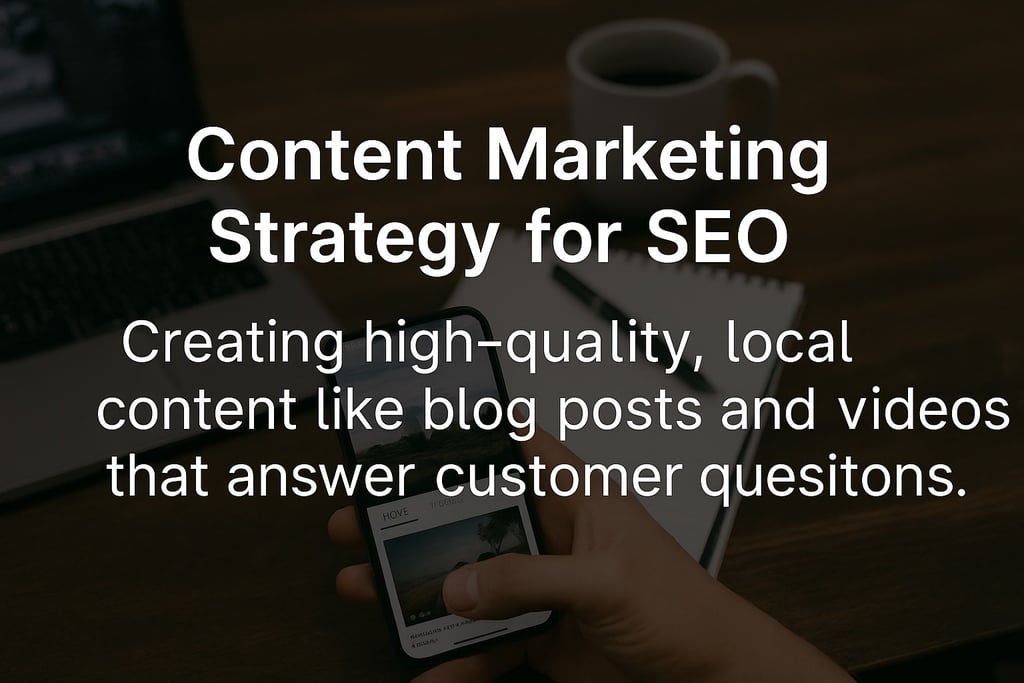GET STARTED - Book a free consultation -or- a $50 Website & SEO Audit report now!
Content Marketing Strategy for SEO
Creating High-Quality Local Content That Attracts Customers in Australia
8/6/20253 min read


In today’s digital world, content is more than just king—it’s your best salesperson. A solid content marketing strategy for SEO helps Australian businesses rank higher in Google, build trust with local audiences, and convert browsers into buyers. Whether you’re running a small business in Sydney, a trade service in Toowoomba, or an eCommerce site targeting Brisbane, creating high-quality, local content is a powerful SEO weapon.
In this guide, we’ll break down how to craft a winning content marketing strategy focused on blog posts, videos, and answering customer questions—all tailored for the Australian market.
⸻
Why Content Marketing Matters for SEO in Australia
Search engines like Google prioritise content that is useful, relevant, and answers real user questions. Australian customers are turning to Google to ask:
• “What’s the best plumber in Brisbane?”
• “How much does soil testing cost in Toowoomba?”
• “Best NDIS providers near me.”
If your website content doesn’t answer these questions, you’re losing traffic to competitors who do. That’s where SEO content marketing comes in—helping you show up in local searches and establish credibility in your niche.
⸻
Step 1: Identify What Your Customers Are Searching For (Keyword Research)
The foundation of great content starts with knowing what your audience is Googling. Use tools like:
• Google Keyword Planner
• Ubersuggest
• Google’s “People Also Ask” box
• AnswerThePublic
For local Australian SEO, focus on long-tail keywords such as:
• “affordable electrician in Sunshine Coast”
• “Toowoomba soil testing services”
• “NDIS cleaning provider Brisbane”
Make a list of common questions or pain points customers have. This becomes your content calendar.
⸻
Step 2: Create Value-Packed Blog Posts
Blogs are one of the best tools for SEO content marketing. When done right, they drive organic traffic, help build internal linking, and increase domain authority.
Best Practices for SEO Blogs:
• Use headings (H1, H2, H3) with keywords
• Answer a specific question or solve a problem
• Keep it local: use Australian spellings, place names, and context
• Include internal links to your services pages
• Add a CTA (Call-to-Action) like “Contact us for a quote today”
📌 Example Titles for Aussie Businesses:
• “Top 5 Mistakes People Make Choosing a Plumber in Cairns”
• “Why Soil pH Testing is Essential for Queensland Farmers”
• “How to Boost Local Google Rankings for Brisbane Tradies”
⸻
Step 3: Use Video Content for Better SEO
YouTube is the second-largest search engine in the world—and Google loves showing video results. Create short, helpful videos (1–3 minutes) answering customer questions or showcasing your work.
🎥 Video Ideas:
• “What Happens During a Soil Test in Roma, QLD?”
• “Behind the Scenes of Our Website Design Process”
• “How Our SEO Helped a Local Business Get More Leads in 30 Days”
Embed these videos on your blog posts and share on socials to drive more traffic.
⸻
Step 4: Focus on Localised Content
Google’s local algorithm wants to serve location-specific results. Make sure your content mentions cities, suburbs, or regions you serve.
✅ Example:
Instead of saying: “We offer plumbing services.”
Say: “We offer plumbing services across Brisbane’s northside, including Chermside, Aspley, and Zillmere.”
The more localised, the better for Google Maps listings, Google Business Profiles, and “near me” searches.
⸻
Step 5: Answer FAQs Clearly and Concisely
Build an FAQ section on your website or at the end of each blog. Use real questions people ask on Google.
🔍 Why?
Because Google may use these answers in a featured snippet or voice search result. Huge win!
🎯 Example:
Q: How much does SEO cost for a small business in Australia?
A: SEO for small businesses in Australia typically ranges from $500 to $2,000/month depending on the scope and services required.
⸻
Step 6: Track and Improve Your SEO Content
Use tools like Google Search Console, Google Analytics, or Ahrefs to track:
• Which blog posts are getting traffic?
• What keywords are driving clicks?
• Where are people dropping off?
Update your older content with better headlines, new keywords, or updated info to keep it ranking.
⸻
Final Tips for a Strong SEO Content Marketing Strategy
• Post consistently (weekly or fortnightly is great)
• Don’t write for Google—write for humans, then optimise
• Include relevant keywords naturally (no stuffing)
• Use schema markup where possible (FAQ, video, local business)
⸻
Conclusion: Build Trust and Traffic with Local Content
A smart SEO content marketing strategy helps your Australian business stand out. Whether you’re offering agronomy consulting in Goondiwindi, web design in Sydney, or SEO services in Brisbane, quality content will:
✅ Improve your Google rankings
✅ Attract more local customers
✅ Build trust with your audience
Start by publishing one helpful blog post or video a week. Focus on your customers’ questions, and Google will reward you with clicks, leads, and conversions.
Our Solutions for you
Expert SEO, website design, content creation and digital marketing services.
Serving South East Queensland including Darling Downs, Lockyer Valley, Toowoomba and Brisbane in person.
All work is done in Australia.
Connect
SEODevPro
+61 493258833
info@SEODevPro.com
© 2025. All rights reserved. OneMindSoftware ABN 33 129 219 462
Created using Hostinger Web Builder
Mon-Fri 9:00 - 17:00 AEST
Business Hours


Want a FREE Password Manager that requires:
- No login
- No memory
- No cloud
Check out https://calcpass.app
